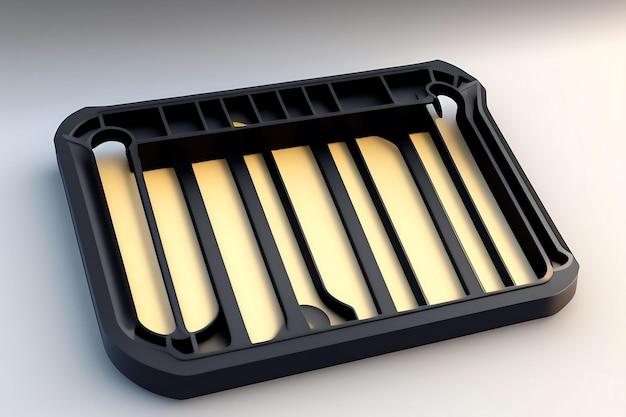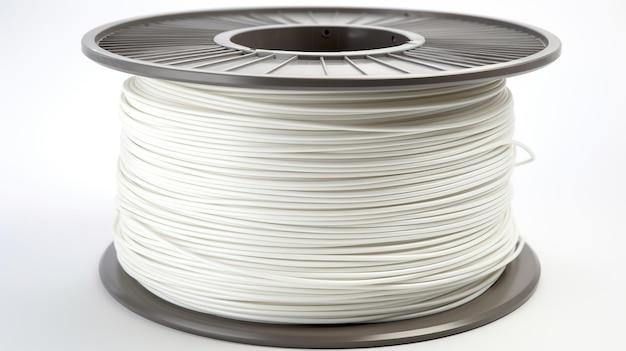3D printing has revolutionized the world of manufacturing, allowing individuals to bring their ideas to life with just a few clicks. But as convenient as it is, 3D printing also raises concerns about the safety of the materials used, particularly ABS plastic. In this blog post, we will explore the disadvantages of ABS plastic, its effects on indoor air quality, and most importantly, how to filter the air when working with ABS. Whether you’re a seasoned 3D printing enthusiast or just starting out, understanding the risks associated with ABS and learning how to protect yourself is a crucial step towards a safer printing environment.
The popularity of 3D printing has given rise to questions like whether it’s safe to print ABS indoors or if PLA is a better alternative. We’ll address these concerns and dig deeper into the potential health risks associated with ABS fumes. Additionally, we’ll explore the safety and advantages of PETG, another popular material used in 3D printing, and compare it to ABS.
Join us as we uncover the answers to these questions and provide practical tips on how to ensure the air quality in your 3D printing workspace remains healthy and free from harmful particles. Stay informed and make informed decisions to enjoy the world of 3D printing without compromising your health.
How to Filter and Improve Air Quality for 3D Printing
Why Filtering the Air for ABS 3D Printing Matters
When it comes to 3D printing, one aspect that often gets overlooked is the air quality. Sure, we obsess over getting the perfect print, tweaking the settings, and selecting the right filament. But what about the air we breathe while our 3D printer is hard at work? Think about it: those tiny particles released during printing can have a bigger impact on our health than a plot twist in a blockbuster movie. That’s why it’s essential to filter the air and ensure we’re not inhaling anything funky. So, here are some nifty tips to keep the air clean and your lungs happy.
Selecting the Right Filament and Fan Combo
Let’s start by addressing the filament we use. ABS (Acrylonitrile Butadiene Styrene) is notorious for emitting volatile organic compounds (VOCs) and ultrafine particles. A simple way to tackle this issue is by opting for filaments with lower VOC emissions. PLA (Polylactic Acid) and PETG (Polyethylene Terephthalate Glycol) are great alternatives that have less impact on air quality. Additionally, tweaking your printer’s fan settings can help in circulating the air and reducing the concentration of particles.
Choose a Proper Ventilation Setup
Ventilation is key when it comes to 3D printing. Setting up a dedicated space for your printer with proper ventilation can make a world of difference. If you’re lucky enough to have a ventilation system installed in your workshop or office, make sure it’s functioning efficiently. If not, fear not! You can still DIY your way to cleaner air. A portable air purifier, strategically placed near your printer, can help capture and filter out those pesky particles, leaving you with air as fresh as mountain dew.
Activated Carbon Filters: Your Best Friends
Now, let’s talk filters. When it comes to tackling VOCs, nothing does it better than activated carbon filters. These little superheroes have an affinity for organic compounds, trapping them like a pro. So, investing in an air purifier with activated carbon filters can work wonders in removing harmful particles from the air. Just make sure the filter is properly rated and compatible with your air purifier model. But hey, filtration systems don’t have to be limited to your printer area alone. Place one in your workspace, and your colleagues will thank you for being the air quality superhero!
The Art of Airflow Management
Managing the airflow in your printing space can significantly improve air quality. One simple trick is to create a positive air pressure environment. How? By strategically placing fans near your printer to push the air away from you, preventing those particles from reaching your nose. Oh, and let’s not forget about negative pressure. Creating a vacuum in a separate enclosure and connecting it to your printer’s ventilation can further minimize particle dispersion, creating a cleaner and safer printing environment.
Regular Cleaning: No Dust Bunnies Allowed
Lastly, cleanliness is essential. Regularly cleaning the printer and workspace helps reduce dust accumulation and keeps those sneaky particles from hitching a ride and floating around. Take a few moments to wipe down your printer and surrounding surfaces, ensuring a dust-free zone. A clean workspace not only promotes better air quality but also sparks joy in the heart of any neat freak.
Inhale Confidence, Exhale Clean Air
Now that you’re armed with these awesome tips for filtering and improving air quality for ABS 3D printing, go forth and conquer the world of additive manufacturing. Remember, a printer can only perform its best when the air it breathes is at its finest. So, take care of your printer, take care of yourself, and breathe in that confidence of knowing you’re making the world a cleaner place, one print at a time. Happy printing!
FAQ: How To Filter Air Abs 3D Print
What are the disadvantages of ABS plastic
ABS plastic has a few disadvantages. First, it tends to warp and shrink during cooling, which can result in print failures or inaccuracies. Second, ABS releases potentially harmful fumes when heated, requiring proper ventilation during printing. Lastly, ABS is more susceptible to UV degradation, making it less ideal for outdoor applications.
Can I print PLA in my room
Yes, printing PLA in your room is generally safe. PLA filament is made from plant-based materials and does not release toxic fumes when melted. However, it’s still a good practice to have proper ventilation to remove any odors or particulates generated during the printing process.
Is ABS safe to print indoors
Printing ABS indoors can be done safely, but it requires good ventilation. ABS emits fumes that may contain irritants and toxins when heated. Ensure your workspace is well-ventilated or consider using an air filtration system to filter out these fumes and maintain a healthy environment.
Is ABS water-resistant
ABS plastic is not naturally water-resistant. While it can withstand occasional exposure to water, prolonged or constant contact with moisture can cause it to degrade or warp. If you require water-resistant prints, it’s better to consider alternative materials like PETG or nylon.
Do PLA printers need ventilation
While PLA produces fewer fumes compared to ABS, it’s still a good idea to have proper ventilation when printing with PLA. Ventilation helps remove any odors or particles generated during the printing process, ensuring a pleasant and healthy environment.
Why is ABS so bad
ABS has gained a reputation for being “bad” due to a few reasons. Firstly, it releases potentially harmful fumes when heated, which requires adequate ventilation. Secondly, ABS is more challenging to print with compared to other materials, as it requires precise temperature control and adhesion to the build surface. Lastly, its tendency to warp and shrink during cooling can result in print failures or inaccuracies.
How bad are ABS fumes 3D printing
ABS fumes can be harmful if inhaled in high concentrations over an extended period. These fumes may contain irritants and toxins that can cause respiratory discomfort or health issues. It is important to prioritize proper ventilation or utilize air filtration systems when printing with ABS to reduce exposure.
Is PLA safe to breathe
Yes, PLA is generally considered safe to breathe. Unlike ABS, PLA filament is made from plant-based materials and does not emit toxic fumes when melted. However, if you notice any noticeable odors or irritation during printing, it’s best to ensure proper ventilation in your printing area.
Does PETG release VOCs
PETG does release a minimal amount of VOCs (Volatile Organic Compounds) during the printing process. However, the levels of VOCs emitted from PETG are significantly lower compared to ABS. Adequate ventilation is still recommended to maintain a comfortable and healthy workspace.
Is PETG better than ABS
PETG and ABS have their own strengths and weaknesses. PETG is generally easier to print with, has better layer adhesion, and is more flexible compared to ABS. On the other hand, ABS is stronger and more temperature-resistant than PETG. The choice between the two depends on specific project requirements and personal preference.
Is PETG safe for pets
PETG is considered safe for pets. It is non-toxic and has high chemical resistance. However, it is always advisable to keep all 3D printed objects, including those made with PETG, out of reach from pets to avoid any potential hazards or ingestion.
Is ABS or PLA better for 3D printing
The choice between ABS and PLA depends on various factors. PLA is easier to work with, biodegradable, and suitable for most general-purpose applications. ABS, on the other hand, offers greater strength, durability, and temperature resistance. Consider the specific requirements of your project to determine which material is better suited for your needs.
Is PETG safe to drink from
While PETG is considered safe for many applications, it is not recommended to use PETG 3D printed objects for drinking purposes. Although PETG is food-safe, it is challenging to ensure the cleanliness and sterility of 3D printed items due to layer lines and potential bacterial buildup.
Do you need ventilation to print ABS
Yes, proper ventilation is necessary when printing with ABS. ABS emits potentially harmful fumes when heated, which can cause discomfort or health issues if inhaled. Ensuring good ventilation or using an air purifier with activated carbon filters helps safeguard your respiratory health.
Is ABS toxic when burned
Burning ABS can release toxic fumes and byproducts, which can be harmful to human health. It is important to never intentionally burn ABS or any other plastic and to dispose of waste material responsibly according to local recycling guidelines.
Can you filter ABS fumes
Yes, ABS fumes can be filtered using an appropriate air purifier or filtration system. Activated carbon filters are particularly effective in capturing and neutralizing the potentially harmful components of ABS fumes, providing a cleaner and healthier printing environment.
Does a 3D printer need an air purifier
While not mandatory, using an air purifier with a 3D printer can be beneficial. An air purifier filters out potentially harmful particles and odors, ensuring a cleaner and healthier environment. It helps reduce the concentration of fumes emitted during printing, making the air safer to breathe.
Can PETG go in the dishwasher
PETG is generally not recommended for use in the dishwasher. While it has good chemical resistance, exposure to high temperatures and harsh dishwasher detergents may cause it to warp, become brittle, or lose its structural integrity. Handwashing is the preferred method for cleaning PETG objects.
Is printing PETG toxic
Printing with PETG is generally considered safe and does not release toxic fumes in significant quantities. However, it’s still essential to maintain proper ventilation during the printing process to ensure a comfortable and healthy environment.
Is 3D printed ABS food safe
3D printed ABS objects are not considered food-safe. ABS has the potential to harbor bacteria in its porous structure and may contain trace amounts of additives that may not be suitable for food contact. If you require food-safe 3D prints, it’s recommended to use materials like FDA-approved PLA or PETG instead.
Disclaimer: The information provided in this FAQ is for general informational purposes only and is not intended as a substitute for professional advice. Always consult with a qualified expert or relevant authority for specific guidance related to your 3D printing projects and safety requirements.

